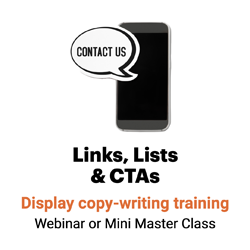8 approaches to avoid
What’s in a name?

A great headline can mean the difference between a story that gets read — or one that gets passed over.
So what’s the headline formula that will produce compelling headlines that appeal to search engines as well as to your target audience? Whether you’re writing a blog post, news release or social media status update, try these tips for drawing readers in with your headlines:
1. Avoid vague heads.
These are actual headlines that appeared in actual publications:
Prepare for the worst
Help me cope
Keeping it together
These headlines are so vague, they could all apply equally to stories about my husband getting ill, my business going bankrupt or my finding out that the mini-mart is out of Twix bars.
If your headline could apply to any story, you shouldn’t use it for any story. The best headlines are ultra-specific. Write a unique headline for your unique story.
2. Tighten loose heads.
These, too,are actual headlines that appeared in actual publications:
Preparing for the successful sale of your business
(I’m sure there was a more successful way to write this headline.)
What is intellectual property, and why should you care about it?
( I already don’t care about it, because this is such a bad headline.)
Vague heads are less like headlines than story ideas. “I know, let’s do a story on what is intellectual property, and why should you care about it?”
A story idea isn’t a headline. Good headlines take time and effort to write.
3. Reverbify label headlines.
In 1986, The New York TImes ran a column about Canada’s campaign to forge a free-trade deal with the United States. The headline:
Worthwhile Canadian Initiative
Michael Kinsley, then the editor of The New Republic, declared it to be the most boring imaginable headline.
Label headlines — like Worthwhile Canadian Initiative — are boring. They identify the topic without saying anything about it. They are nouns or noun phrases without verbs.
Here, for example, are a few of the label heads that have crossed my desk lately:
Bulletins
Chemical update
Field distribution
Graphics systems
Strategy statement
With label headlines, you miss the chance to reach the huge and growing percentage of your audience who just read the display copy. You lose readers who rely on headlines to draw them into the story. And you sap the energy from your pieces, because labels have no verbs.
But a headline isn’t just a topic.
Avoid label headlines.
To fix label headlines, say something about the topic, and make sure your subject has a verb.
instead of:
Charity Collection for Geneva and Africa
Write:
Help African orphans, vulnerable children, Manchester’s poor
Donate to XYZ’s autumn charity collection Oct. 15-31
Verbs are power words. Make sure your headline has one.
4. Stop ing-ing.
Who ever decided that “Present Participling Noun” was a clever headline? You’ve seen (maybe even written!) ing-ing headlines like these:
Introducing the Strategic Growth Incentive
Making dams safer for fish around the world
Ending Child Trafficking through Collaboration, Awareness, and Support
So what’s wrong with “Introducing the Strategic Growth Incentive”?
Ing-ing headlines focus on your organization’s actions instead of the reader’s needs. They suck the subject out of the headline. And they substitute present participles — weak nonverbs — for power words, like verbs.
When you find these headlines in your own copy, rewrite. Use subject, verb, object. Then you’ll end up with power words like stoke, step, shape and turn.
And that will put the energy back in your headline.
5. Skip the buzzwords.
Chris Smith, senior lead communications specialist at Entergy, writes:
Not to pick on an otherwise fine industry publication that shall be nameless, but I saved for this column a recent, scary headline (adults strongly cautioned —some content may be too intense for some viewers). Ready?
FERC, Maine Sign OCS Hydrokinetics MOU
This in a publication not, as far as I know, aimed only at the 12 people who know all of those concepts. I know what FERC is, and I once bought shoes in Maine, for which I think I signed a check.
If you find yourself writing a headline with more than two acronyms plus a five-syllable word, maybe you should stop going to lunch with the engineers.
Indeed. And if you’ve crammed “strategic,” “value-added,” “proactive,” “solution” and “core competencies” into your headline, it’s a bad headline.
6. Skip ‘headline words.’
Copy editors — who must often squeeze sense into a headline or subject line with very few characters — have developed a vocabulary of super-short words.
You see these terms in headlines, but rarely anyplace else. They’re words like:
- Accord for agreement
- Eyes for sees
- Flap for controversy
- Ink for signs
- Irk for irritate
- Mull for consider
- Nab for steal
- Nix for cancel
- Pact for contract
- Pan for criticize
- Scribe for writer
- Slate for schedule
- Veep for vice president
- Vie for compete
- Weigh for consider
- Woes for miseries
- Woo for persuade
Don’t use these words in your headlines. Instead, steal the idea behind these “headline words.” Use more familiar one-syllable words to develop sharp heads of your own.
7. Don’t drop key elements.
Is there a deadline for responding to your message? Create a sense of urgency with a call to action in the headline.
Are you writing to a subset of your target audience: asthma sufferers, maybe, or single moms? Consider calling out to them in the headline.
If there’s a key element to the story, consider including it in the headline.
8. Don’t make the reader groan.
John Russial, associate professor at the University of Oregon, begs you to stop writing headlines like:
The pear facts about anjous
Plan for a fence at jail has some neighbors railing
Rail plan is … on track … off the track … at a crossroads … going downhill … going uphill … moving at full throttle … huffing and puffing like the little engine that could
And anything taxing around April 15.
9. Avoid confusing the reader.
Books bulge with confusing headlines. Among my favorites:
NFL to ask its players to donate brains for study
Ouch!
Include your children when baking cookies
Yum!
Statistics show that teen pregnancy drops off significantly after age 25
Yup! Or even after age 20.
Read more ridiculous headlines.
10. Don’t get it wrong.
Read far enough into the body copy to get the headline right. A catchy headline does nothing if the information it relays is incorrect.
“Make sure the big type does not contradict the little type,” writes Russial.
Here’s one that does contradict the little type, from Inc. magazine:
Hot Tip: Set Cost-Cutting Targets
Head first.
Want to convince people to click to read, increase conversion rates and social shares, boost content marketing results and otherwise improve the ROI on your message? Write more compelling headlines.
Headlines get twice the attention of body copy. They change the way people think. And they’re the gateway to your message.
Lose readers in the headline, and you’ll likely lose them altogether.

Leave a Reply